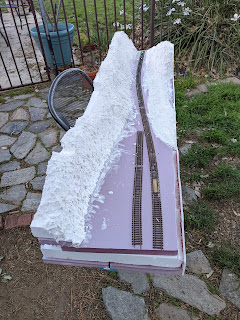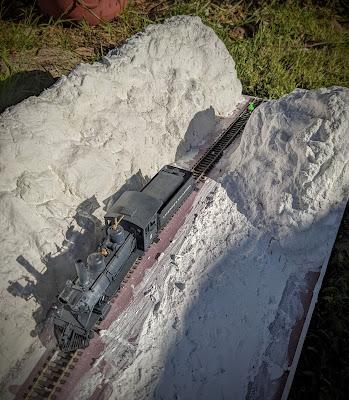Over the weekend, I started building a 16” x 64” diorama.
I’ve been pretty inactive in the hobby for about 15 years. Now that I’m nearing retirement I’m thinking about building another small-to-medium layout (4 x 8 island to as large as a 9 x 15 U-shape). At this point, I’m debating whether to stay with HO (I have a lifetime accumulation of HO equipment) or switch to On30 (I really like the heft and detail, and I’m a sucker for old-time narrow gauge trains). The diorama is meant as a warm-up for that.
I wanted to get a feel for building track and one or two structures in O scale, and try out some new construction techniques, like foam construction and Sculptamold instead of plaster. I plan to hand lay the track, to see if my eyesight and patience as still up to it. The finished product will provide a place to display some of my On30 equipment and do a little photography. It will mostly live on a shelf in my garage/train room, but will be lightweight enough to move outdoors to take pictures.
These pictures show the glued-up foam structure, a mix of pink extruded foam and beadboard, and what it looks like with a first coat of Sculptamold. Rock castings come next. There are also a couple of shots with a train to give a sense of scale. The track you see is some old HO flex pinned in place for location. Yes, in the past I have normally laid track before building scenery, but I got all excited gluing up foam and the next think I knew, there were mountains.
 |
Here you can see those foam "boulders" in the cut. I also glued bits of scrap foam on the hillside to break up the profile of the ridgeline.
Overall view with Sculptamold. The flat area at the bottom in this picture will be the site of a small mining operation. Originally, I was thinking of a small station, but a think a mine is more in keeping with the theme I'm going for here. I'm thinking I may just have an ore bin (Berkshire Valley has one that I have my eye or, or it would be easy enough to scratchbuild -- I have plans for a couple of different designs). Maybe a small supply shack or office building next to it. See the little notch in the ridgeline on the left? The mine car track will disappear through that notch, and the mine itself will be a flat or photo, just visible behind the ridge. I will likely shift the tracks just a bit father right (toward the front edge of the module).
 |
| Detail from the castings is visible here on the outcropping on the right, where the light hits it at an angle. |
 |
| You can't see a lot of rock detail here, but it's a nice side-on shot of the loco. |
Next up, painting. I like to start with a coat of gray/tan latex flat interior house paint, tinned about 50-50 with water, then thin washes of artist acrylics or craft paint in various earth tones to add variation, and finally a thin wash of black to bring out the detail. I don't think I have any tan paint on hand, so I need to make a trip to Home Depot for one of their little sample jars of an appropriate color. One of the most satisfying things in model railroading for me, and certainly the best for the price, is watching scenery come to life when you apply some color. Stay tuned.
 |
| This is the cut where the engine is positioned in earlier shots. I especially like the boulders on the left. |
 |
| Some layered sedimentary rock. Area on the left isn't done yet. |
 |
| Another view of the rock cut. |







Comments
Post a Comment